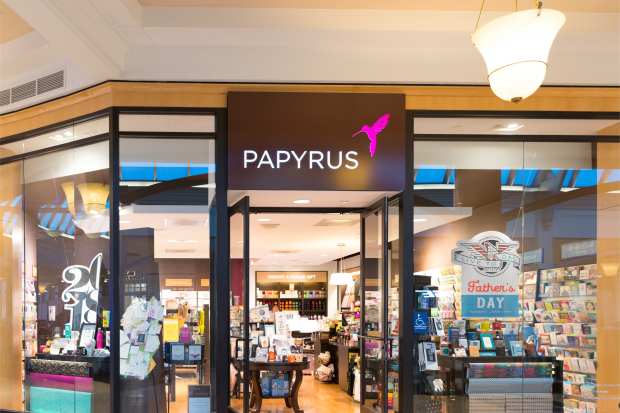Despite Papyrus’ Closing, Stationery Retail Is Not All Doom-And-Gloom

Not to be cynical, but mention the world “stationery” to people these days and odds are they minds will move toward a similar word, stationary — the concept of lack of motion, as in a couch potato or a broken-down car on the side of the road. That’s understandable, given how viciously email, texting and other forms of digital and mobile communication have displaced actual writing — which, of course, would seem to reduce the need for actual stationery products.
New evidence of that — part of the broader trend of the existential changes in the world of brick-and-mortar retail, changes that are gaining more focus this month — comes from reports that stationery chain Papyrus is closing up shop. The first Papyrus store opened in 1973, when cursive writing was a core part of grade-school education, much to the delight of many nostalgists but which still can spark memories of horror among those of us cursed with atrocious handwriting. The chain had since expanded to some 260 or so retail locations.
“Papyrus parent company Schurman Retail Group had been attempting to renegotiate lease terms for its stores, but apparently not enough concessions were made to help save the company’s locations,” the report stated. “While it’s unclear yet if Papyrus’ e-commerce site and wholesale business will remain in operation, the business will be conducting liquidation sales at its stores.”
Millennials to the Rescue
The move has much more to do with the decline of handwriting, of course.
The experience of buying, sending and receiving greeting cards continues to undergo changes in a world where social media and sparkling, decorated texts often suffice for getting across congratulatory messages. But that doesn’t mean greeting cards are going the way of personalized letter-writing paper or envelope openers.
Indeed, there are solid reports out there that millennials — that scapegoated generation blamed for the demise of certain fast-casual restaurant chains, densely-packed pieces of primeval carbon (aka diamonds) and other consumer mainstays — are helping to keep the greeting card industry alive.
As NPR put it not so terribly long ago, “over the past year, greeting card revenue has been steady. The greeting card industry could bring in as much as $933 million this Valentine’s Day [2019], up a bit from last year’s estimated $894 million.” No doubt the next edition of that Hallmark-friendly holiday will produce even more bits of good news for the greeting card industry, assuming the trends hold. “Greeting card experts say it’s younger people and millennials, in particular, who have been keeping the industry afloat. And they’re buying fancier specialty cards, often with personal touches,” the report stated.
Brick-and-Mortar View
None of that will save the Papyrus retail chain. And its seems very likely that its remaining brick-and-mortar competitors, along with its brick-and-mortar peers, will either have to find ways to all but reinvent themselves for the 2020s or start looking for bankruptcy lawyers and liquidation specialists. Further evidence in support of that larger point is emerging in these first weeks after the 2019 holiday shopping season, when merchants and industry experts take stock of the latest consumer data.
During the last part of 2019, physical retail certainly had some shining moments here and there. That is reflected in recent Fiserv data that show brick-and-mortar retail growth during the 2019 holiday season stood at 1.4 percent. That said, eCommerce growth during that period saw a relatively robust 8.1 percent growth rate. Total retail growth was 3.8 percent.
In fact, in a recent PYMNTS interview about that holiday shopping season data, Glenn Fodor, senior vice president of data and analytics at Fiserv (First Data), made the case — not a new one, but still important — that online shopping can do a much a better job when it comes to giving shoppers exactly what they want. Combine that with the way much of the global population has moved beyond old-fashioned paper for many forms of correspondence and expression, and you can see why brick-and-mortar stationery stores are not in a desirable spot. Other factors involved in these changes include the rise of big-box office supply stores, and the trading-in of ink for pixels.
Recycling and Distribution
That’s not all, according to one deep treatment of the broader office supply and stationery store landscape. “Stationery stores were affected by consumers’ increasing environmental concerns,” it said. “However, many consumers did not want to compromise on price or quality, and some environmentally friendly paper products were more expensive than those made from virgin material.”
Even as overall sales decline and chains close, stationery retailers that still exist do benefit, at least in general, by the rising desire among consumers for unique, crafty or old-fashioned products — descriptions that can apply to many stationery items. That will require, however, that such retailers learn to adopt relatively sophisticated digital and mobile marketing strategies. But as that analysis noted, “for the future, many sources predict that independent dealers would be fewer in number and the surviving units would likely combine into new associations and groups. National distribution networks and more partnering relationships between manufacturers, wholesalers and dealers were expected to introduce more efficiencies to the stationery distribution system.”
It’s unclear how the demand for personalized products, and the always-present desire to engage in nostalgic consumerism, will play out among stationery retailers in the coming years. The outlook certainly doesn’t look good, but, then again, certain forms of stationery appear likely to endure for a while.
